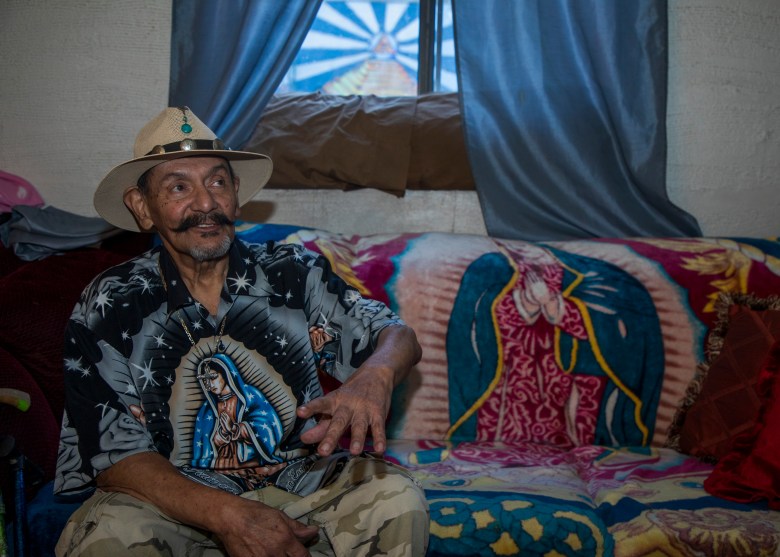Everything about Carlos Cervantes is monumental, including his Virgen de Guadalupe murals and his endurance in the face of an antiquated law that could keep him on parole for the rest of his life.
As a 71-year-old who lives in the aftermath of a stroke that impairs his abilities, Cervantes is the only person in New Mexico convicted of a nonviolent crime who is still on parole under indeterminate sentencing laws that were repealed 45 years ago.
Cervantes spent most of his adult life in and out of prison due to the criminalization of his substance use disorder, compounded by the scarlet letter of having his home in Santa Fe raided by the police in 1978. He was sentenced to between 34 and 170 years in prison after a jury found him guilty of five counts of drug trafficking.
“When they first put me in prison, I thought, ‘Ahí los wacho!’” Cervantes said. “I thought I was never going to be outside again.”
The raid on “Los Cervantes”
During the 1960s and 1970s, Santa Fe’s historic Barrio de Analco was a working-class neighborhood where life could be rough. Prior to Cervantes’ arrest, his family lived in New Mexico for generations, and in Barrio de Analco, he was a known artist who advocated for Chicano youth.
Sam Leyba, an activist and artist who grew up with Cervantes, said that barrio youth enjoyed growing up by the Santa Fe River, which runs parallel to the neighborhood. But over time, the water slowly dried up, rents climbed sharply, and a new illness hit the streets: heroin. Leyba, 74, told Prism that in the early ’70s, some in the barrio decided to address community needs independently from the city government that seemed more concerned with policing them. Locals created the community organization La Gente, and in 1972, the group opened a clinic that provided medical care to thousands of people. La Gente also addressed police harassment when it decided to “police the police,” Leyba said, with the creation of a cop watch.
“The police didn’t want nothing to do with us. They called us communists,” Leyba said. “There were some good cops, and then there were real bad ones. There were cabrones that would shoot you and wear leather gloves to beat the shit out of you.”
Local Chicano youth organized with the help of Godfrey Reggio of the Christian Brothers, a Roman Catholic pontifical order.
“The police were fucking around in the community,” Reggio told Prism. “They didn’t go to the fancy parts. They were all in the barrios, and they were fucking people up. We had the 10-code, and so we knew what they were saying. We had police radios and we would arrive there before [them], and we had rifles. ‘Don’t fuck with us, we’ll fuck with you.’ And that scared the shit out of them.”
Reggio eventually left Santa Fe to become a renowned filmmaker whose experimental movies have garnered worldwide recognition, especially the 1983 cult classic “Koyaanisqatsi,” a Hopi word meaning “life out of balance.”
“The reason I made ‘Koyaanisqatsi’—it was all motivated from my work with gangs, that these kids are fine. It’s the world they live in that’s fucked up,” Reggio said. “And that’s what ‘Koyaanisqatsi’ is about: a world out of balance, a crazy life.”
Cervantes’ world was thrown out of balance on Jan. 30, 1978, when around 170 cops from 11 state, county, and local agencies conducted the largest raid in northern New Mexico history. The local press embedded with the police during the raid, recalled Don Frederick, who at the time was a young reporter working for the Santa Fe New Mexican newspaper. Before the raid, police briefed reporters at a diner around 4:30 a.m., explaining that “the particular target and the particular concern” was a home referred to as “Los Cervantes,” Frederick said.
“The concern about the potential for a gunfight was focused on that particular compound,” the journalist said. “There was concern that this was a family that had had a lot of interactions with the cops in terms of drug abuse, and that particularly Carlos Cervantes—then in his mid-20s—was a fellow who they were most concerned about in terms of the potential for violence.”
Frederick said he did not witness the raid, but he received information from the journalists who were at the scene. Police obtained a warrant based on information from a confidential informant who reportedly saw heroin inside the Cervantes house. However, according to one of the only surviving legal documents, police found no drugs.
“Law enforcement officials refused to say if the investigations and raids led to recovery of large amounts of heroin,” according to the news story published on the day of the raid.
That morning, a photo of a handcuffed Cervantes appeared above the fold on the front page of the New Mexican. He became public enemy No. 1—a reputation he still can’t shake.
They threw the book at him to make an example and also to get a leader out of the community. They don’t want leaders around.
Sam Leyba, artist and activist from Barrio de Analco
“They threw the book at him to make an example and also to get a leader out of the community. They don’t want leaders around,” Leyba said. “If you’re a leader and people follow you and you have the mentality of a revolutionary—you want to make changes? You end up in jail.”
Unusually harsh
The territory of New Mexico adopted indeterminate sentencing 115 years ago in March 1909, three years before gaining statehood. Under indeterminate sentencing, judges assigned minimum and maximum terms according to a felony classification. A person would have to complete at least one-third of the minimum before being released on parole for the remainder of the maximum. Determinate parole, on the other hand, sets definite sentences and probation.
Indeterminate sentencing laws were first conceived in 1870 when the National Prison Association set out to standardize prison practices. In 1870, the first telephone patent had yet to be issued, and the automobile hadn’t been invented.
In 1978, Judge Edwin Felter sentenced 25-year-old Cervantes to 34 to 170 years in prison for drug trafficking. Felter’s judgment came one year before indeterminate sentencing ended in New Mexico. State legislators revised the criminal code to adopt definite sentences starting July 1, 1979.
“When the sentencing law changed, everybody who was under the old law remained under the old law. There was no retroactivity,” said former New Mexico Parole Board chair Sheila Lewis, who has practiced law in Santa Fe since the 1980s.
Cervantes’ sentence was unusually harsh, especially when compared to other sentences for more serious and violent crimes. In another unrelated case from the same time period, Felter sentenced a man to 10 to 50 years for rape. The only real evidence against Cervantes was the sale of $292 worth of drugs to two undercover police officers.
Retired Judge Michael E. Vigil, who as a young attorney represented Cervantes in his appeal, said that in the 1970s, there was an expectation from the public for police and judges to tackle crime and the rising tide of heroin use.
“A lot of the judges were harsh and especially in drug trafficking, because, again, that was the issue,” Vigil, now 73, said. “Everybody was talking about drug addiction and how we needed to do something to stop it. And longer sentences were the answer.”
In 1994, former New Mexico Gov. Bruce King appointed Vigil to New Mexico’s First Judicial District, a bench he held for 18 years until his retirement in 2012. Three years into his tenure in 1997, Vigil launched one of the first adult drug courts in Santa Fe, which offered substance use treatment programs and alternatives to prosecution for felony drug crimes. Had Cervantes been offered this, Vigil said, his life could have been different.
“He would have had some help dealing with the issues that caused him to use drugs,” Vigil said. “The frustration, all of the things that a person goes through in life that causes you to self-medicate and you don’t even know that you have a mental illness … or how to deal with the drug addiction.”
There is scientific consensus that brain development continues into our 20s. This relatively recent finding has led to sentencing reform in multiple states. But old cases like Cervantes’ rarely benefit from these new findings, said George Lyon, law professor at New Mexico Highlands University.
“In Mr. Cervantes’ case, the amount he was caught with and the punishment are imbalanced,” Lyon told Prism in an email. “He should be granted a pardon, commute, or reprieve, as our society and the criminal justice system’s continued support of long-term incarceration is expensive, a waste of resources that could be better used in proactively addressing the underlying issue of addiction and actual criminal actors.”
Despite his old age and impairment, Cervantes can at any moment return to prison for a parole violation. But state prisons are not equipped to deal with the needs of an elderly incarcerated population, much less people suffering from conditions like Cervantes’.
In 2016, while incarcerated for violating his parole and also recovering from a stroke, Cervantes had a seizure. When emergency personnel transported him to the ambulance, they lost control of Cervantes’ gurney, causing it to topple over. According to the ambulance report, Cervantes hit his head and there was bleeding from his right ear. When admitted to the University of New Mexico Hospital emergency department, a CT scan “showed a right temporal bone fracture” and “traumatic” brain bleeding.
“The patient was significantly altered at that point and on exam had his eyes open spontaneously, was looking around, but would not necessarily regard or follow commands briskly,” the emergency room report reads.
Cervantes retained an attorney but refrained from pursuing legal action against the ambulance service and state corrections officials.
“Prisons are not hospitals, and prisons weren’t made to treat the elderly and those with medically fragile conditions. The people who are impacted the hardest are the elderly and geriatric people who are serving the most amount of time while also being the least dangerous,” said Stephen Taylor, executive director of (De)serving Life, a New Mexico organization focused on legal reentry services for current and formerly incarcerated people.
Throughout his life, Cervantes has been treated harshly by the criminal legal system—even after performing a heroic deed during the February 1980 New Mexico State Penitentiary riot, one of the deadliest in U.S. history. At least 33 inmates were killed, and seven prison guards were severely injured during the 36-hour uprising. Affidavits obtained through a records request show that Cervantes saved two prison guards during the ordeal.
In his August 1983 affidavit, correctional officer Larry E. Mendoza stated that Cervantes was with him and officer Edward Ortega for most of the riot, offering “protection, reassurance, and making sure” that no harm came to them.
“I am certain that his protection helped to save my life,” Mendoza stated.
Cervantes said in Spanish that he risked his life to protect the two correctional officers because they treated inmates humanely.
“[Mendoza] was a good vato that did not fuck with the inmates like the other guards,” Cervantes said. “There was a little room where we took them. We told him and the other guard, ‘Come over here with us, we’ll protect you here.’”
In September 1983, then-New Mexico Gov. Toney Anaya commuted the sentences of 13 people labeled as “heroes”—including Cervantes—due to their “meritorious actions” during the 1980 uprising. Cervantes’ sentence went from between 34 and 170 years to between 31 and 170 years. He was released on parole in 1984.

Justice denied
Attorneys, legal experts, and even a former state judge agreed that Cervantes’ lifelong parole is unfair and a waste of public resources. Records obtained by Prism from the New Mexico Corrections Department show Cervantes’ parole is scheduled to expire on June 8, 2055, when the artist would be 101 years old. The records also show that people incarcerated in the state who were accused of kidnapping, murder, and rape received lesser or similar indeterminate sentences to Cervantes, who at the time of his sentencing was a first-time drug offender.
“Forty years is a long time,” said Lewis, the former parole board chair. “I don’t really think I’ve ever met anyone who was [imprisoned] under the old law and is on … lifetime parole.”
Lewis said Cervantes’ case faces significant challenges, including antiquated sentencing laws and the current parole board’s attitude toward incarcerated people.
“The only way he could attack this would just be to say: In the interest of justice, [this] should be changed,” she said. “But what I know is they don’t even give justice to people who are model prisoners. Now, people who have used drugs and relapsed in their use—forget about it. There’s no ‘in the interest of justice.’”
Records from the New Mexico Corrections Department show that Cervantes is among 20 elderly people still on parole under New Mexico’s indeterminate sentencing laws. All but Cervantes were convicted of violent crimes.
The state parole board, which can choose to discharge Cervantes at any time, has decided not to, despite his health condition, his significant contributions to New Mexico’s arts and culture, and his respected standing in the community.
During the New Mexico Parole Board quarterly meeting in July, Parole Board Chair Abram Anaya told Prism that the indeterminate sentence given to Cervantes was similar to those for people who committed “false imprisonment, murder, or rape.”
Anaya also said the board had the authority to discharge a person from indeterminate sentence parole five years after their release from prison. The parole board chair asked Prism to share the details of Cervantes’ case so that he could “look into it.”
During the parole board’s December meeting, Anaya, a retired Santa Fe deputy police chief and a college football referee, said he didn’t know Cervantes was a featured artist at the Museum of International Folk Art in New Mexico. Anaya also said he did not fully review Cervantes’ case, despite multiple emails from Prism since August detailing the case to Anaya and the board’s executive director, Roberta Cohen.
“I’ve looked at the case. I need to get more involved. I need to look at it a little bit further. They’re trying to pull more background information so that I can talk about this more educationally,” Anaya said.
Under a New Mexico statute, it is up to the corrections department to identify geriatric, permanently incapacitated, and terminally ill inmates, notify them of the opportunity to apply for medical or geriatric parole, and recommend the release of those who are eligible.
Cervantes said he has never received any such communication, not even after the seizure that led to a skull fracture and brain hemorrhage while in custody in 2016.
In previous cases, the parole board released people imprisoned under the old sentencing laws. Records obtained by Prism show that on May 24, a 71-year-old was discharged after receiving two, 100-year sentences for killing his seven-month-old son in 1974. The details of his release and discharge from parole remain unclear.
Cervantes only wishes for one thing: to be discharged from parole so that he can visit his father’s grave in Puebla, Mexico.
Cervantes only wishes for one thing: to be discharged from parole so that he can visit his father’s grave in Puebla, Mexico. The conditions of his parole have kept him stuck in Santa Fe County for the last 40 years.
Tired of dealing with a judicial system that has taken most of his life, in 2020 Cervantes applied for executive clemency from New Mexico Gov. Michelle Lujan Grisham. In a letter dated Dec. 28, 2020, the governor denied his application. “After thorough investigation and considering recommendations from the Parole Board Chair,” the governor wrote that she “acknowledges and applauds” Cervantes’ efforts to better his life.
“‘Applauds’?” Cervantes quipped in response to the letter. “I can’t hear the applause.”
A cultural icon
Prison isn’t Cervantes’ whole story. He is a cultural icon, a beloved New Mexico artist who has promoted art inside and outside of prison. Although police narrative paints him as a hardened criminal, institutions like the Museum of International Folk Art recognize his contributions to art, culture, and society.
“Carlos’s legacy as an artist, father, and community organizer is legendary among both Santa Fe locals and visitors,” according to a statement from the museum. “His work can be seen as a testament to his experience with the often challenging system of incarceration, and a critique on how these systems disproportionately affect certain segments of society.”
Cervantes’ artistry is the one aspect of his life the carceral system can’t control. In a region internationally acclaimed for its arts and culture, Cervantes’ murals contribute to Santa Fe’s “City Different” landscape. Two of his pieces, along with a replica of one of his murals, are on display at the Museum of International Folk Art through September as part of the exhibit “Between the Lines: Prison Art & Advocacy.”
His work, sometimes biographical, draws upon the visual aesthetic of the Chicano movement, featuring Indigenous Nahuatl imagery and renditions of Our Lady of Guadalupe.
“Guadalupe is part of mi familia; she’s someone of our sangre,” Cervantes said. “She’s helped me with my life, and I’ve always had her with me everywhere. She’s with me, and she’s waiting for me. When I get to meet her, [I’ll tell her]: ‘I’m here. I’m here. They finally threw me out.’”
Editorial Team:
Tina Vasquez, Lead Editor
Carolyn Copeland, Top Editor
Rashmee Kumar, Copy Editor
This post was originally published on this site be sure to check out more of their content.






